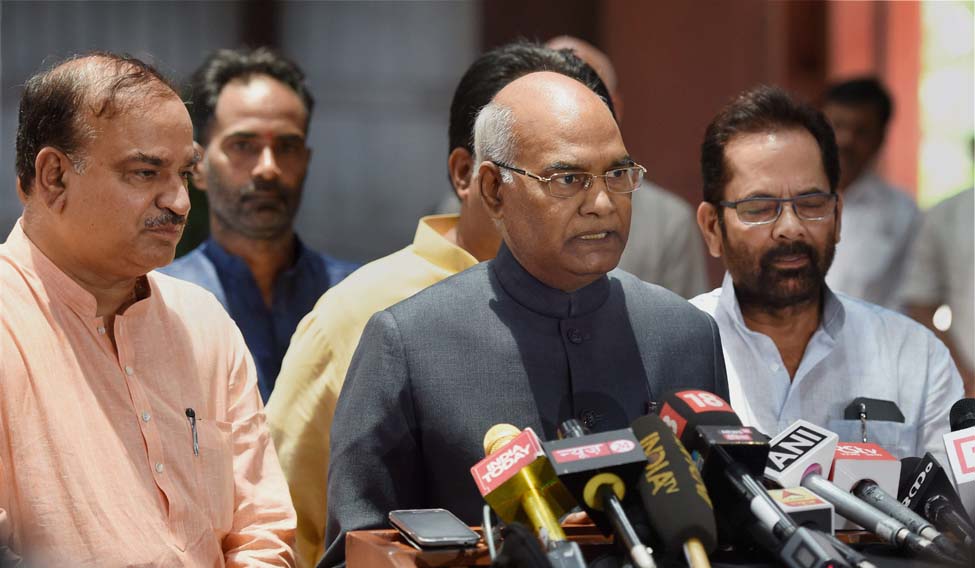A tumultuous week at Raisina Hill
By Rekha Dixit
It was a week of hurried activity at Raisina Hill. The next resident of Rashtrapati Bhavan was nominated and preparations are in full swing for a meeting between Prime Minister Narendra Modi and US President Donald Trump. In the midst of all this came the International Yoga Day celebrations and a shocker from Pakistan, in the form of former naval commander Kulbhushan Jadhav's second "confessional" video, following which Islamabad reported that he had asked for clemency.
External Affairs Minister Sushma Swaraj didn't contort her body into twisted yogic postures, but her speech at a special yoga day for diplomats at the Pravasi Bharatiya Bhavan was gripping. As various diplomats stretched out their yoga mats, Swaraj asked them to repeat the word shanti. "Shanti is a very easy word, we can all chant the same, " she said. A good idea to steer clear of the controversial om.
The MEA also steered in a new air freight route between India and Afghanistan. Two aircrafts flew between Kabul and Delhi on June 19; The one leaving India was loaded with a 100 tonne cargo of pharmaceuticals, water purifiers and medical equipments. The Kabuliwallah aircraft, however, arrived redolent with a 60 tonne cargo, mainly asafoetida (hing), a condiment that Afghanistan produces. The spicy flavour of the bilateral ties was for all, especially Pakistan, to see and smell. Pakistan had been creating obstacles in the land trade route via the Wagah border. During Afghan President Ashraf Ghani's visit last year, the two countries decided that they should explore other opportunities rather than let themselves be stonewalled. The flights, however, are flying over the Pakistan's air space.
The fag end of the week was spent criticising Pakistan for its mishandling of the Jadhav case, and the government announced that its fresh pleas (17th) for consular access to Jadhav had gone unheeded again.
A presidential poll that evokes public interest
By Vijaya Pushkarna
Presidential elections are rarely of interest to the public, the way assembly and Lok Sabha polls are. They are not voters, and cannot influence the electoral college directly. But this time around, there is an upsurge in popular interest.
When Prime Minister Narendra Modi and BJP president Amit Shah announced the name of then Bihar governor Ram Nath Kovind as their presidential candidate, 'Kovind' trended everywhere in social media. It was possibly the most searched name that day. A quiet and low-key politician, Kovind made a national splash only when he was chosen to run for Raisina Hill.
Ever since the term of the 15th Lok Sabha ended, Meira Kumar's political trajectory had plateaued. She lost the parliamentary elections from her constituency of Sasaram in Bihar in May 2014. The former Lok Sabha speaker's almost girlish voice, her charming smile, were all too familiar.
A d-word has suddenly come to define both their profiles—dalit. The support to both has come largely because of the dalit constituency that the political parties want to appease. This in turn has kindled tremendous interest among the public.
Questions ranged from why she acquiesced to a losing contest, to a very hopeful question— what if she actually manages to woo some of the parties supporting Kovind, and land in that beautiful palace called the Rashtrapati Bhavan.
Venkaiah Naidu launches 'City Liveability Index' for urban development
By Vijaya Pushkarna
Prime Minister Narendra Modi is committed to transforming India. In fact, NITI Aayog, which he chairs, is intended to drive the transformation. Since India cannot transform without its urban centres—many of them now highly polluted, filthy with overflowing garbage and heavily congested—Urban Development Minister Venkaiah Naidu on Friday launched the ‘City Liveability Index’ in the course of a national workshop on urban transformation.
The index will be based on 79 parameters and aims to capture the spread and quality of infrastructure—including education, health, mobility , job opportunities and emergency response. For a start, it will measure the quality of life in 116 major cities. The first set of results may be visible about six months from now.




